Archive
Apple Monitor IIgs (A2M6014Z) Focus problem workaround.
The horizontal measuring was made calculating the ledge at the base of the monitor.
Unfortunately, this monitor suffers from a serious problem of image quality.
The monitor become very hot and the adjustment resistance (trimmer) of the Focus controls that is inside the flyback loses its original value.
After nearly an hour of operation, the image becomes blurred and we must adjust the trimmer of the focus located inside the monitor, that’s why i have made this modification to the external case of the monitor.
The flyback is NOT longer exists as a spare parts.
Datanetics Apple Keyboard Fix.
Datanetics Apple Keyboard Fix.
After a few cold solder joints redone the keyboard works almost perfectly.
Todo:
- The “V” key is totally dead.
- The keys are a bit tired, don’t return always in the original position.
Overall is fine.
Datanetics Apple Keyboard *update*
I found a temporary solution for the tired keys they don’t return always in the original position. I have put a small spring (see the picture). Now the keys works correctly.
About the “V” key completely dead, i have desoldered it and i have tried to spray a air into the slots without having any results, so i have tried a extreme thing, i have used the key switch like a whistle. ;-D I have blown inside several times, the result is the key switch now are working again. I have made the same thing for the “right arrow”.
Apple II Europlus / Keyboard and Floppy Disk Drive Repair
Apple II Europlus / Keyboard and Floppy Disk Drive Repair
Defects:
- The peripheral slots are totally dead.
- Don’t runs programs that take up more than 16k
- The keyboard doesn’t respond properly.
- The Floppy Disk Drive don’t read anything.
Replaced parts:
- Replaced [H12] Decoder/Demultiplexer 74LS138 in the position [H12]
- Replaced 3 x 4116 RAM in the row [D]
Keyboard:
- Cleaned the blades and the contacts on the pcb. Work not recommended to those who have little skill.
Apple Floppy Disk Drive:
- The Floppy Disk Drive (Drive 2) had to be cleaned and oiled.
Macintosh Plus (Sad Face) Repair
Macintosh Plus repair.
Defect:
- Mac sad face with error code not readable.
Replaced parts:
- 2 x ROM (342-0341-B / 342-0342-A) replaced with two EPROM 27C512 (pinout compatible)
Note:
All roms that i have found on the net or sent by friends are not working.
I had to do a dump of the Rom of my Macintosh Plus and at this point everything has worked immediately.
Apple IIe STK Asic Clone (Orange) Repair
Apple IIe STK Asic Clone (Maybe Orange) repair.
Defect:
- Short-circuit on all voltages.
- Black/Garbage screen.
Replaced parts:
- 10 x Tantalum Capacitor 4.7uf (replaced with Electrolytic Capacitors)
- 3 x RAM OKI M3764A-15 in Short-circuit.
- 1 x ROM 1 (EPROM 27128)
Note:
I have to thank immensely my friend Alessandro Polito for providing me the dump of the ROM 1 of the Orange (Apple IIe Asic Clone)
Download:
Hot Line SCSI Box
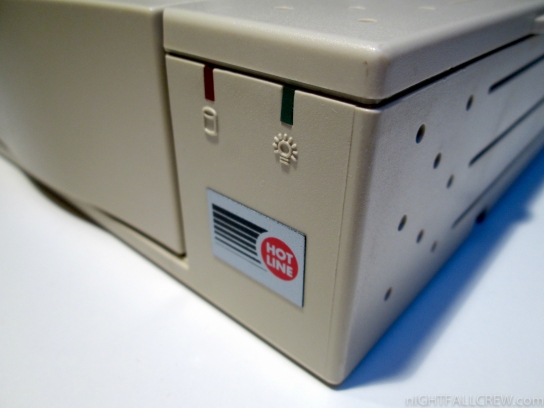
I thank my dear friend that gave me the Hot Line SCSI Box.
Autopsy:
Box for SCSI hard disk.
Description:
- One Slot 3.5″ 50 Pin SCSI hard disk.
- Internal Power supply.
- Lights indicator for power, HDD activity.
- Internal scsi connection cable included.
- External Connections 2 x SCSI 50-pin Centronics female.
- Switch for SCSI ID.
Commodore 64 ASSY 250425 Empty PCB
Memory Expansion Spem EXP-MEM 512k for Sinclair QL
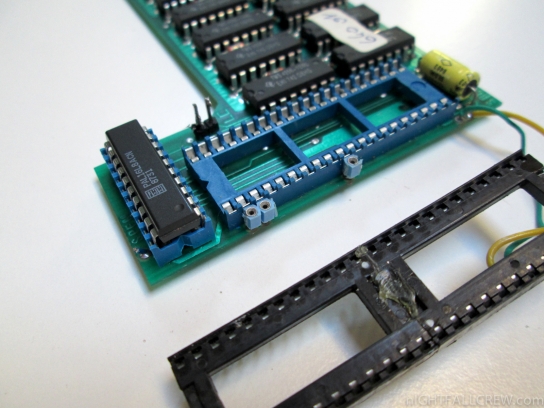
I thank my dear friend that gave me the Spem EXP-MEM 512k.
Autopsy:
Various companies offered to upgrade your QL with an internal memory upgrade. This was normally 512K, but some companies also offered a 256K version.
The method of upgrade was in two ways:
- Removal of the existing QL memory chips and replacement to give a total of 512K
- An internal board, which connects to the 8301 ULA socket, and has a wire to the 68008 processor.
The downside of this method of upgrading the QL’s memory was:
- The memory access was slower than external memory
- You could not use some of the later QL expansions, such as the Trump Card which themselves had memory built into the interface.
Internal interfaces were advertised by a range of companies, including CST, MicroPeripherals and Silicon Express.
source: Sinclair QL Computer Wiki
Staff K8AP Multi-Compatible Keyboard (Apple II/IIe)
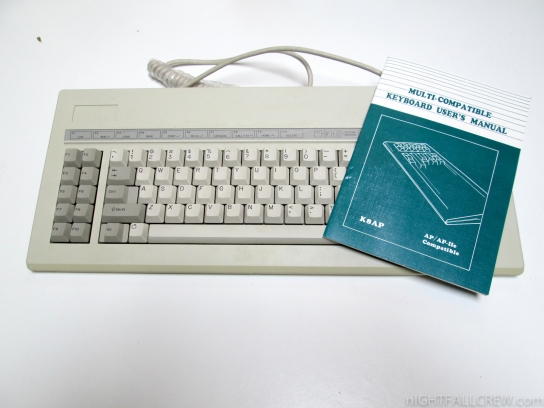
I thank my dear friend that gave me the Staff K8AP Multi-Compatible Keyboard. Unfortunately is missing the adapter card to install inside the computer.
Autopsy:
Compatible keyboard for the Apple II / IIe.
The Atari CX-77 Touch Tablet (Boxed)
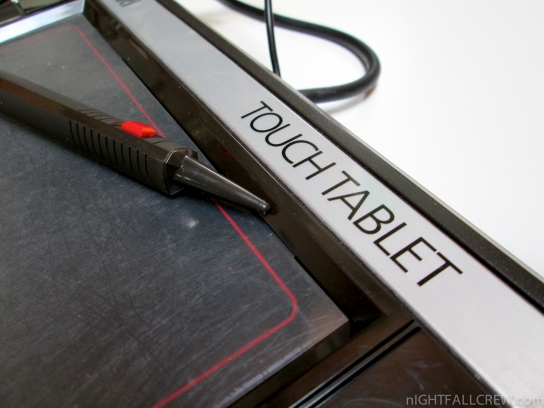
I thank my dear friend that gave me the Atari Touch Tablet.
Autopsy:
The Atari Touch Tablet was a well designed and brilliant idea. Giving the user the ability to use a virtual sheet of paper and pen, they could draw, drag and drop, paint and erase images with the included Atari Artist program.
Perhaps given more time, the Touch Tablet could have been used for many other innovative ideas and perhaps vertical market applications. The Atari CX-77 Touch Tablet was designed by Tom Palecki formerly of Atari’s Industrial Design group.
source: atarimuseum.com
Mivar 9BN2V (Red)

Autopsy:
The Mivar 9BN2V it’s a 9 inches B/W CRT screen with 16 programs preselection with a electronic tuning for each program. It can be powered even with a 12volt and has a headphone jack.
Mivar is an Italian TV-set manufacturer. It was founded by entrepreneur Carlo Vichi in 1945 in Milan. Mivar used to produce radios and CRT televisions, but now produces only LCD LED televisions. Mivar is the last Italian factory of televisions. Their factory is in Abbiategrasso (20 km from Milan).
Since the 80s until 2000 in Italy Mivar TVs have had a very wide spread, in fact these televisions were present in almost every Italian house, in the Italian TV Studios, in schools, hospitals, hotels and prisons, because these CRT TVs were good, cheap, robust and durable.
When the market decided to focus on the LCD TVs, Mivar was unprepared and had serious difficulties. But thanks to the tenacity of the master Carlo Vichi, Mivar introduced in 2010 some new attractive and competitive LCD-CCFL TVs, and in 2011 some new LCD-LED TVs. The televisions made today by Mivar are also particularly simple and rational, with a particular Italian design and front speakers for better sound. Today’s Mivar TVs are all made in Italy.
source: wikipedia
Apple II/II+ (Europlus) ABT Inc. Numeric Keypad
Zanussi/Seleco Ping-o-Tronic (1st Edition – 1975)
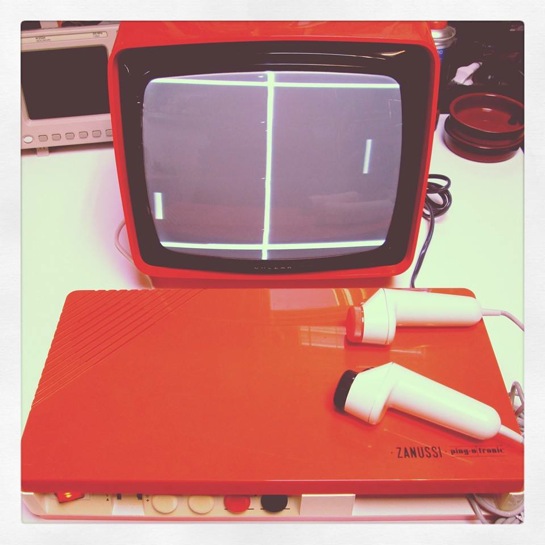
Autopsy:
Zanussi, a well known Italian furniture company, released two game systems: Ping-O-Tronic, an analog game first released in late 1974 but really successful during 1975, and Play-o-Tronic, an AY-3-8500 game released in 1977 (this particular model was also released by Universum in Germany). Zanussi obtained the Sanders Associates License Agreement on April 21st, 1975. Zanussi reported 21,514 Play-o-Tronic units sold between October 1st and December 31st, 1977 (3 months) for a total amount of 620,408,000 lire, on which a 5.5% royalty was paid to Sanders (34,122,440 lire). Considering this amount, each game would have cost around 28,800 lire during this period, which seems quite low. Unfortunately there is no similar information for Ping-O-Tronic.
Ping-O-Tronic is a nice example of an early video game designed with discrete components (over fifty transistors and twenty diodes) and only three TTL chips (7400 type). All of the graphic objets (paddles, ball, boundaries) and sync signals are generated by transistor flip-flops and one-shots. The chips combine the individual signals so as to manage events like collisions between the ball and a paddle, or a lost ball. They may also be used as triggers for the serves.
 This system is quite interesting because it has been improved and upgraded several times. At least nine different models are known to exist, all of which remain on the initial design (PP-2 if not PP-1). Little is known about the first model (PP-1), which dates late 1974. All we know is that it was nearly same as model PP-2 below, and may differ only by one or a few improvements in the electronic circuits (cleaner video signals, etc).
This system is quite interesting because it has been improved and upgraded several times. At least nine different models are known to exist, all of which remain on the initial design (PP-2 if not PP-1). Little is known about the first model (PP-1), which dates late 1974. All we know is that it was nearly same as model PP-2 below, and may differ only by one or a few improvements in the electronic circuits (cleaner video signals, etc).
All of the systems play three games: Tennis, Squash / Solo and Attract / Automatic. Tennis and Squash are the obvious games played by analog systems. Curiously, the Hole in the Wall variant has not been implemented although it would have required minor modifications to invert the video signal of a paddle (or both to play more games). Surprizingly, an Attract / Automatic mode is available, where nodoby plays. Both paddles take the whole screen in height, forming a closed square with the two horizontal boundaries. Thus the ball bounces indefinitely, making a very strange PONG variant that only one other system known to play: Executive Games Electronic Television Tennis. This mode was a very clever way to attract people in shops because it required nobody to demonstrate the unit. You whould simply place it in the window and everybody walking down the street would see it play by itself ! This said, the attract mode designed by Executive Games was more realistic since it involved an intelligent paddle which moved automatically to always catch the ball in a squash game.
Several adjustments can be made. Paddles can vary in height from very small (almost unplayable) to enormous. This rare feature for an analog game certainly allowed young kids to play more easily. The picture can be centered both horizontally and vertically. The system is only powered by the mains (no batteries). Both hand controllers can be stored in the system case when not used.
Although model PP-2 is labeled Zanussi Ping-O-Tronic on the top side, models PP-4 and PP-5 are known to exist as Seleco Ping-O-Tronic. As a matter of fact, Seleco was a trademark of the Zanussi Industries. Other models like PP-6 only show “Ping-O-Tronic” without trademark. We currently ignore if both Seleco and Zanussi labels were used for a same model.
source: pong-story.com
Thomson M06
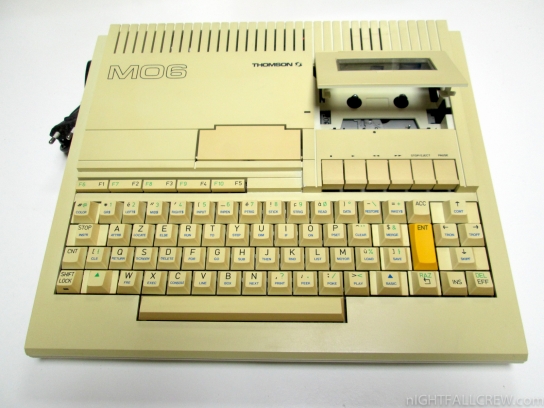
I thank my dear friend that gave me this computer.
Autopsy:
The Thomson MO6 was an 6809E-based computer introduced in France in 1986. It featured 128 KB of RAM, a 40×25 text display, and built-in Microsoft BASIC. The MO6 was available until January 1989. In Italy it was sold by Olivetti with little aesthetic changes, and named Olivetti Prodest PC128.
The Thomson MO 6 was the successor of the Thomson MO 5. This machine was widely used in French schools. It was compatible with the MO 5 and the other members of its family (TO 7, TO 8, TO 9 and TO 9 plus).
It has two versions of BASIC on ROM, one to be compatible with MO5 and BASIC 128 (both made by Microsoft). Almost all memory (101 KB) was accessible with BASIC thanks to a transparent 16 KB bank switching mechanism. An optional 3.5″ floppy disk drive (640 KB) was available.
It had a short life because soon after it was launched, the TO 8 came and challenged to it.
BUILT IN LANGUAGE 2 Microsoft BASIC interpreters – MO5 compatible and BASIC 128
KEYBOARD Full stroke 69 key with 5 function keys and arrow keys
CPU Motorola MC 6809e
SPEED 1 MHz
CO-PROCESSOR Custom Thomson gate array chip
RAM 128 KB
ROM 64 KB
TEXT MODES 40 or 80 chars x 25 lines
GRAPHIC MODES 8 modes, from 160 x 200 to 640 x 200 dots
source: computinghistory.org.uk
















































































































Recent Comments